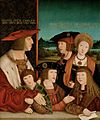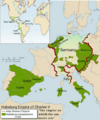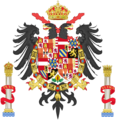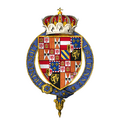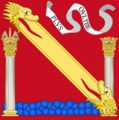Charles V, Holy Roman Emperor facts for kids
Quick facts for kids Charles V |
|
|---|---|

Portrait by Titian, probably with Lambert Sustris, 1548
|
|
| Reign | 28 June 1519 – 27 August 1556 |
| Coronation | |
| Predecessor | Maximilian I |
| Successor | Ferdinand I |
| King of Spain (Castile and Aragon) as Charles I |
|
| Reign | 14 March 1516 – 16 January 1556 |
| Predecessor | Joanna |
| Successor | Philip II |
| Co-monarch | Joanna (until 1555) |
| Archduke of Austria as Charles I |
|
| Reign | 12 January 1519 – 21 April 1521 |
| Predecessor | Maximilian I |
| Successor | Ferdinand I (in the name of Charles V until 1556) |
| as Charles II | |
| Reign | 25 September 1506 – 25 October 1555 |
| Predecessor | Philip I of Castile |
| Successor | Philip II of Spain |
| Born | 24 February 1500 Prinsenhof of Ghent, Flanders, Burgundian Low Countries |
| Died | 21 September 1558 (aged 58) Monastery of Yuste, Crown of Castile |
| Burial | 22 September 1558 El Escorial, Spain |
| Spouse |
Isabella of Portugal
(m. 1526; died 1539) |
| Issue among others |
|
| House | Habsburg |
| Father | Philip I, King of Castile |
| Mother | Joanna, Queen of Castile and Aragon |
| Religion | Catholicism |
| Signature |  |
Charles V (born 24 February 1500 – died 21 September 1558) was a very powerful ruler in Europe during the 16th century. He was the Holy Roman Emperor and Archduke of Austria from 1519 to 1556. He was also King of Spain (as Charles I) from 1516 to 1556, and the ruler of the Habsburg Netherlands from 1506 to 1555.
Charles V was the head of the House of Habsburg, a very important royal family. His lands were huge, including the Holy Roman Empire (Germany and northern Italy), Austria, the Netherlands, and Spain with its kingdoms in southern Italy (Naples, Sicily, and Sardinia). He also controlled vast lands in the Americas, where Spain was building a large empire. His empire was so big that people said "the sun never sets" on it, meaning it was always daytime somewhere in his lands.
Charles inherited all these lands from his grandparents at a young age. He spent most of his life fighting wars to protect his empire. He fought against the Protestant Reformation (a big religious change), the expanding Ottoman Empire, and France. He traveled a lot, moving his court around his many territories. His armies were made up of soldiers from different parts of his empire, like German, Spanish, and Italian troops. To pay for his wars, he borrowed a lot of money from bankers.
During his rule, Spanish explorers like Hernán Cortés and Francisco Pizarro conquered the Aztec Empire and Inca Empire in the Americas. This brought a lot of silver to Spain, but it also caused prices to rise. Charles also faced rebellions in Spain and Germany, which he put down. He tried to keep his empire united under the Catholic faith, especially as Protestantism grew.
Eventually, Charles V decided to give up his power. In 1556, he divided his empire between his son, Philip II of Spain, who got Spain and the Netherlands, and his brother, Ferdinand I, Holy Roman Emperor, who became the Holy Roman Emperor and ruler of Austria. Charles then retired to a monastery in Spain and died two years later.
Contents
Early Life and Family
Charles was born in Ghent, a city in what is now Belgium, in February 1500. At first, he was expected to inherit only the lands of Burgundy (the Netherlands). But things changed quickly.
His parents were Philip the Handsome and Joanna of Castile. Philip was the son of Maximilian I, Holy Roman Emperor, and Joanna was the daughter of Isabella I of Castile and Ferdinand II of Aragon, the famous "Catholic Monarchs" of Spain.
When Charles was very young, his parents left him with his step-grandmother, Margaret of York, and later with his aunt, Margaret of Austria, Duchess of Savoy. She was a smart and artistic woman who greatly influenced Charles. His tutors taught him about simple living and chivalry, the code of knights.
In 1506, his father Philip died. His mother Joanna was considered unable to rule due to mental health issues. So, Charles became the Duke of Burgundy. In 1516, his grandfather Ferdinand II of Aragon died, and Charles inherited Spain and its lands in the Americas, Naples, Sicily, and Sardinia. He ruled Spain as King Charles I, sharing the title with his mother, though she remained confined. In 1519, his grandfather Maximilian I died, and Charles inherited Austria and was elected Holy Roman Emperor. He chose the name Charles V for his main title, aiming to be like the great emperor Charlemagne.
Charles's Vast Empire
Charles V ruled over many different lands, each with its own history and people. He spent much of his life traveling between them.
The Netherlands and Burgundy
Charles inherited the Habsburg Netherlands from his father. These lands included what is now Belgium, the Netherlands, and Luxembourg. They were very wealthy due to trade and industry. Charles loved his homeland and spent a lot of time in cities like Brussels. He united all the provinces under his rule. In 1549, he made a rule called the Pragmatic Sanction of 1549, which said these lands would always stay together and be inherited by his family.
The Spanish Kingdoms
In 1516, Charles became King of Spain (Castile and Aragon) along with his mother, Joanna. Spain also included lands in the Americas and kingdoms in Italy like Naples and Sicily. At first, many Spaniards saw Charles as a foreign ruler because he grew up in the Netherlands and didn't speak Spanish well.
Two big rebellions, the Revolt of the Comuneros and the Revolt of the Brotherhoods, challenged his rule in the 1520s. After these, Charles started to rely more on Spanish advisors and spent more time in Castile. His motto, "Plus Ultra" (meaning "Further Beyond"), became Spain's national motto. Spain provided many soldiers and a lot of silver from its American colonies, which helped fund Charles's wars. However, many Spaniards felt their resources were being used for wars that didn't benefit Spain.
Italian Lands
Charles's Spanish inheritance included the kingdoms of Naples, Sicily, and Sardinia. As Holy Roman Emperor, he also had power over several states in northern Italy. The Duchy of Milan was a key area that France wanted to control.
Charles fought several wars with France over Italy. In 1525, his forces captured the French King Francis I at the Battle of Pavia. Charles eventually gained control of Milan in 1535. However, his trade in the Mediterranean Sea was often attacked by the Ottoman Empire and their corsairs.
The Americas
From his grandmother Isabella I, Charles inherited Spain's lands in the Americas. These included the Caribbean islands and parts of mainland America. The Spanish empire grew greatly during his reign with the conquest of the Aztec Empire by Hernán Cortés and the Inca Empire by Francisco Pizarro.
Charles set up new systems to rule these distant lands. He created the Council of the Indies in 1524 to manage the colonies. He also established new governments called viceroyalties in Mexico City (1535) and Lima (1544). When large amounts of silver were found in Mexico and Peru, Charles made sure the silver went to the royal treasury.
He also issued new laws in 1542, called the New Laws, to protect the native people from being exploited by Spanish settlers. This was partly due to the efforts of a friar named Bartolomé de las Casas. These laws caused some rebellions among the Spanish colonists, but Charles worked to restore royal control. To meet labor needs, Charles also authorized the direct transport of enslaved people from Africa to the Americas.
Major Conflicts
Charles V's reign was full of wars. He fought to protect his empire and the Catholic faith.
Wars with France
Much of Charles's time was spent fighting against France, led by King Francis I of France. France felt surrounded by Charles's vast empire and wanted to expand its own power, especially in Italy.
They fought several wars. In 1525, Charles's forces captured Francis I. Francis was forced to give up claims to some lands, but he later broke the treaty. Another war led to Charles's soldiers sacking Rome in 1527. Eventually, Charles and Francis made peace in 1529. More wars followed, often with changing alliances, but neither side gained a clear victory.
Conflicts with the Ottoman Empire
Charles also constantly fought against the Ottoman Empire and its powerful sultan, Suleiman the Magnificent. The Ottomans were expanding into Central Europe and the Mediterranean.
In 1529, the Ottomans besieged Vienna, but Charles's forces stopped them. However, parts of Hungary fell under Ottoman control. In the Mediterranean, Ottoman fleets and Barbary pirates attacked Spanish and Italian coasts, harming trade. Charles tried to form alliances against the Ottomans, but they remained a strong threat throughout his reign.
The Protestant Reformation
A major challenge for Charles was the Protestant Reformation, which began with Martin Luther in Germany. As Holy Roman Emperor, Charles wanted to keep his empire united under the Catholic Church.
In 1521, Charles called Luther to the Diet of Worms to explain his ideas. Luther refused to change his views, and Charles declared him an outlaw. However, Luther was protected by some German princes.
As Lutheranism spread, it led to revolts and religious divisions in Germany. Charles tried to find a peaceful solution and held meetings to discuss the differences. But when the Protestant princes formed the Schmalkaldic League and refused to accept the Council of Trent (a Catholic meeting), Charles went to war against them. He won a major victory at the Battle of Mühlberg in 1547, capturing key Protestant leaders. However, the religious divisions continued, and in 1555, Charles's brother Ferdinand signed the Peace of Augsburg, which allowed German princes to choose either Catholicism or Lutheranism for their lands. This officially divided Germany religiously.
Marriage and Family Life
Charles V married his first cousin, Isabella of Portugal, in 1526. Their marriage was initially a political arrangement, but they fell deeply in love. Isabella was beautiful and charming, and she also spoke Spanish, which was important for Charles. Her large dowry helped Charles with his war expenses.

The couple had a happy marriage, and Isabella often served as regent of Spain when Charles was away. She was a skilled ruler and impressed him with her political decisions. They had seven children, but only three survived to adulthood: Philip, Maria, and Joanna.
Isabella died in 1539 at the age of 35 after a difficult pregnancy. Charles was heartbroken and never remarried. He wore black for the rest of his life to show his grief. He commissioned famous painter Titian to create portraits of Isabella, which he kept with him always.
Charles also had a few children born outside of marriage, including Margaret of Parma and John of Austria, who later became a famous military leader.
Charles's Siblings
Charles had five siblings who also played important roles in European history:
| Name | Birth | Death | Notes |
|---|---|---|---|
| Eleanor | 15 November 1498 | 25 February 1558 | Married the King of Portugal, then the King of France. |
| Isabella | 18 July 1501 | 19 January 1526 | Married the King of Denmark. |
| Ferdinand | 10 March 1503 | 25 July 1564 | Became Holy Roman Emperor after Charles. |
| Mary | 15 September 1505 | 18 October 1558 | Served as governor of the Netherlands. |
| Catherine | 14 January 1507 | 12 February 1578 | Married the King of Portugal. |
Charles's Children
Charles and Isabella had seven legitimate children:
| Name | Portrait | Lifespan | Notes |
|---|---|---|---|
| Philip II of Spain |
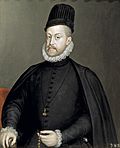 |
21 May 1527 – 13 September 1598 |
His only surviving son, who took over his Spanish crowns. |
| Maria |
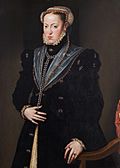 |
21 June 1528 – 26 February 1603 |
Married her cousin, who became Holy Roman Emperor. |
| Ferdinand |
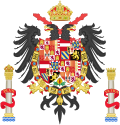 |
22 November 1529 – 13 July 1530 |
Died as a baby. |
| Son |
 |
29 June 1534 | Stillborn. |
| Joanna |
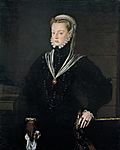 |
24 June 1535 – 7 September 1573 |
Married her cousin, the Prince of Portugal. |
| John |
 |
19 October 1537 – 20 March 1538 |
Died as a baby. |
| Son |
 |
21 April 1539 | Stillborn. |
Charles also had five children born outside of marriage, including:
- Margaret of Parma (1522–1586), who became Duchess of Florence and Parma.
- John of Austria (1547–1578), who became a famous military leader.
Health and Retirement
Charles V suffered from a condition called mandibular prognathism, which caused his lower jaw to stick out. This was a common trait in the Habsburg family due to many marriages between close relatives. He also suffered from gout, a painful joint condition, which got worse as he aged.
Between 1554 and 1556, Charles decided to give up his many titles and retire. He divided his vast empire. His son Philip II received Spain, the Netherlands, and the Italian kingdoms of Naples, Sicily, and Milan. His brother Ferdinand I became the Holy Roman Emperor and ruler of Austria.
Charles officially announced his retirement in Brussels in October 1555. He then sailed to Spain in September 1556 and moved into the Monastery of Yuste in 1557. He continued to follow events in his former empire, but his health declined. He died on 21 September 1558, at the age of 58, likely from malaria. He was buried in the monastery, but later his son Philip moved his body and Isabella's to the grand El Escorial in Spain, where they rest together.
Legacy and Culture
Charles V is remembered as a powerful and complex ruler. Historians often see him as a capable leader, though his financial decisions and some political goals are debated.
He is remembered in many ways:
- Statues of Charles V can be found in cities like Granada, Palermo, and Ghent.
- He appears as a character in plays, operas, and films, often showing his struggles with power, religion, and family.
- Some beers in Belgium are named after him, celebrating his love for beer.
- A popular chocolate bar in Mexico is called "Carlos V," with the tagline "The King of Chocolates."
Images for kids
-
The Palace of Coudenberg in Brussels from a 17th-century painting. Brussels was a main seat of Charles V's court.
-
The exterior of the Palace of Charles V in Granada, built upon his wedding to Isabel of Portugal in 1526.
-
Pope Clement VII and Emperor Charles V on horseback under a canopy, by Jacopo Ligozzi, c. 1580. It shows the entry of the Pope and the Emperor into Bologna in 1530, when Charles was crowned by Clement VII.
-
A panorama of Augsburg, a main German seat of the Imperial court and location of many Imperial Diets presided over by Charles V.
-
Francis I and Charles V made peace at the Truce of Nice in 1538.
-
Charles V in the 1550s, after Titian.
-
Detail of a tapestry depicting the conquest of Tunis in the Tapestry Room of the Alcázar Palace in Seville.
-
Summons for Martin Luther to appear at the Diet of Worms, signed by Charles V.
-
The second tapestry in the series Battle of Pavia by Bernard van Orley: The Marquis of Pescara leading an Imperial attack on the French cavalry and Georg von Frundsberg leading the Landsknechte against the French artillery.
-
The bronze effigies of Charles and Isabella at the Basilica in El Escorial.
-
Don John of Austria, natural son of Charles during his widowhood.
-
In Allegory on the abdication of Emperor Charles V in Brussels, Frans Francken the Younger depicts Charles V dividing the world between Philip II of Spain and Emperor Ferdinand I.
-
Deathbed of the emperor at the Monastery of Yuste, Cáceres.
-
Statue of Charles V in Granada, Spain.
-
Escutcheon of Charles V, watercolour, John Singer Sargent, 1912. Metropolitan Museum of Art.
-
Emperor Charles V and Empress Isabella. Peter Paul Rubens after Titian, 17th century.
-
Equestrian armour of Emperor Charles V. Piece drawn from the collection of the Royal Armoury of Madrid.
-
Arms of Charles, Infante of Spain, Archduke of Austria, Duke of Burgundy, KG at the time of his installation as a knight of the Most Noble Order of the Garter.
-
Variant of the Royal Bend of Castile used by Charles V, Holy Roman Emperor.
See also
 In Spanish: Carlos I de España para niños
In Spanish: Carlos I de España para niños
- Royal Armoury of Madrid
- Museum of Military History, Vienna


